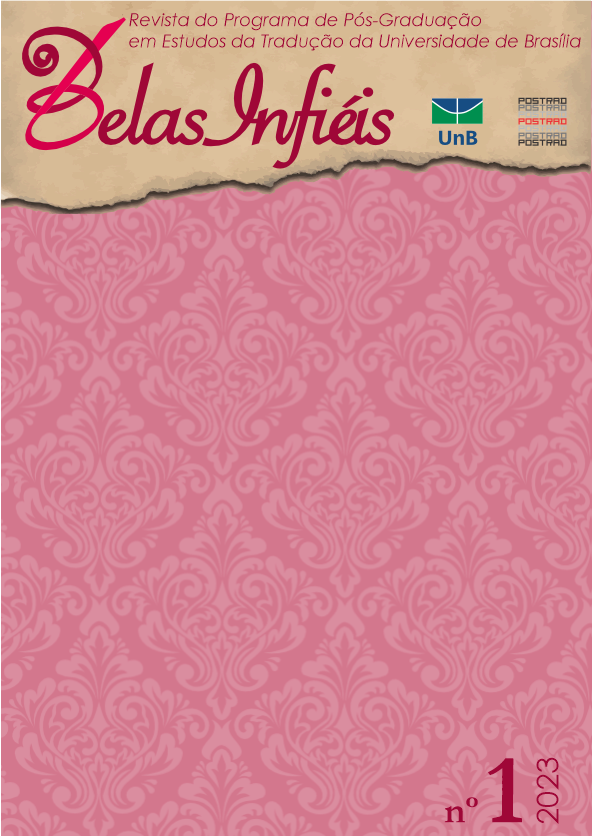Imagens de livros ilustrados: identidades convergentes ou divergentes?
DOI:
https://doi.org/10.26512/belasinfieis.v12.n1.2023.48179Palabras clave:
Tradução da Literatura Infantil. Livros Ilustrados. Narrativas Visuais. Piggybook. Clifford, the Big Red Dog.Resumen
O objetivo deste artigo é discutir a construção de significados em livros ilustrados de modo a estabelecer provável empatia com o leitor prospectivo. Como parte de um estudo mais amplo, seu interesse está nos livros Piggybook, de Anthony Browne, e Clifford, the big red dog, de Norman Bridwell, e suas respectivas traduções para o português, enfocando-se as ilustrações e os desenhos dos personagens de uma perspectiva da complementaridade entre os dois modos semióticos, imagem e verbiagem (linguagem verbal). Na área de tradução de livros ilustrados, os estudos buscam o suporte das artes para enfocar os desenhos de personagens e os efeitos que podem ter sobre escolhas feitas nos textos traduzidos. Nos estudos linguísticos, os livros ilustrados têm sido examinados da perspectiva da sociossemiótica, com base na gramática do visual, que não contempla o estudo das imagens em sequência. O presente trabalho é relevante por vincular-se à tradução de livros ilustrados e usar outra vertente da sociossemiótica como método de análise: a leitura de narrativas visuais em livros ilustrados, isto é, a leitura das imagens em sequência. Considerando as relações de complementaridade da imagem e da verbiagem na construção de significados nos livros analisados, o estudo sugere que diferentes construções nos textos originais e nos textos traduzidos têm efeito sobre os significados dos temas de Piggybook e Clifford, the big red dog.
Descargas
Citas
Alvstad, C. (2008). Illustrations and Ambiguity in Eighteen Illustrated Translations of Hans Christian Andersen’s “The steadfast Tin Soldier”. Meta, 53(1), 90–103.
Alvstad, C. (2010). Children’s Literature and Translation. In Y. Gambier, & L. van Doorslær (Orgs.), Handbook of Translation Studies (v. 1, pp. 22–27). John Benjamins Publishing Company.
Bridwell, N. (2010). Clifford, the Big Red Dog. Scholastic Inc.
Bridwell, N. (1995). Pacheco, o cachorro gigante (M. C. Machado, Trad., 6ª edição). Ediouro.
Browne, A. (1986). Piggybook. Dragonfly books.
Browne, A. (2013). O livro dos porquinhos (M. Mouro, & I. Buratti, Trads.; 2ª edição). Kalandraka Editora Portugal Ltda.
Hunt, P. (2010). Crítica, teoria e literatura infantil (C. Knipel, Trad.). Cosac Naify.
Kress, G., & van Leeuwen, T. (2006). Reading Images: The Grammar of Visual Design. (2nd edition). Routledge.
Magalhães, C. M., & Lee, I. B. (2022). A gradação da agência e emoção na construção da (in)segurança no livro ilustrado Into the Forest, de Anthony Browne, e sua tradução para o português. Cadernos de Tradução, 42, 1–39. https://doi.org/10.5007/2175-7968.2022.e82754
Nikolajeva, M., & Scott, C. (2011). Livro ilustrado: palavras e imagens (C. Knipel, Trad.). Cosac Naify.
Nikolajeva, M. (2014). Memory of the present: empathy and identity in young adult fiction. Narrative works: issues, investigations & interventions, 4(2), 86–107.
Nodelman, P. (1988). Words About Pictures: The Narrative Art of Children’s Picture Books. The University of Georgia Press.
Oittinen, R. (2000). Translating for Children. Taylor & Francis Group e-library.
O’Sullivan, E. (2006). Translating pictures: the interaction of pictures and words in the translation of picture books. In G. Lathey (Ed.), The Translation of Children’s Literature: A Reader (pp. 113–12). Multilingual Matters.
Painter, C., Martin, J. R., & Unsworth, L. (2013). Reading Visual Narratives: Image Analysis of Children’s Picture Books. Equinox.
Painter, C. (2018). Multimodal Analysis of Picturebooks. In B. Kümmerling-Meibauer (Ed.), The Routledge Companion to Picturebooks (pp. 420–428). Routledge.
Shavit, Z. (1986). Poetics of Children’s Literature. The University of Georgia Press.
Descargas
Publicado
Cómo citar
Número
Sección
Licencia
Derechos de autor 2023 CC BY

Esta obra está bajo una licencia internacional Creative Commons Atribución 4.0.
Copyright Statement
Given the public access to this journal, the texts are free to use but requires the recognition of the original authorship and initial publication in this journal to be properly stated.
The journal allows the use of works published for non-commercial purposes, including the right to submit the work to publicly accessible databases. Published contributions are the sole and exclusive responsibility of the author(s).
- When submitting papers to be evaluated by the Belas Infiéis journal, the author(s):
- Declare that the contents of the contributions are original and of their original creation, being entirely responsible for their content if there is an objection by third parties.
- Claim to be aware that they should not commit academic plagiarism.
- Declare that the manuscript has not been published, completely or partially, in Portuguese or another language. If it is a translation it should be submitted to the Translated Articles section.
- Declare that the manuscript is not being evaluated by other journals.
- Declare that the manuscript was not submitted to another journal simultaneously.
- Commit(s) to inform the journal of any kind of error or inaccuracy in their contribution (published, in evaluation or in editing) and to collaborate with the editors to make due corrections of the article (when in evaluation or editing) or erratum/retraction (after publication).
- Declare that there is no conflict of interest regarding the published work.
- Authorize its release if it is accepted for publication without any kind of monetary compensation.
- Agree to assign non-exclusive rights to publication to the magazine, remaining free to make their contribution available in other media as long as the publication of the first version in Belas Infiéis magazine is mentioned. They also authorize Belas Infiéis to assign their texts for reproduction in content indexers, virtual libraries and similar platforms.
- Maintain copyright and grant the journal the right of first publication, the work being licensed under theCreative Commons Attribution License.
- Is/Are allowed and encouraged to publish and distribute their work online after the editorial process, which may increase the impact and citation of the published work.
- Authorize the editorial team to make textual adjustments and to adapt the article to the publication rules, when necessary.



















